E-Zuiko Auto-T 100mm f/2.8 & Zuiko AUTO-T 100mm f/2.8
Although its focal length is twice as long, this 100mm lense is approximately having
the same size (telephoto ratio: 0.93) and weight almost comparable to a conventional
standard 50mm lense. However, because of its 24° angle of view, it produces images twice as
large. It has been designed to deliver similar high resolution and contrast as a
50mm ZUIKO standard lense but it provides a more natural perspective which makes
it such an ideal lense for half-body length portraiture photography. Naturally, it
can be used in a wide varieties of application such as travel, scenic, candid as
well as fan excellent lense for indoor studio shots.
 |
EAST ORANGE |
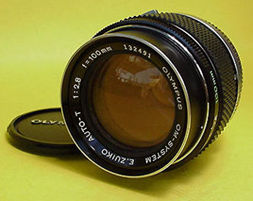 |
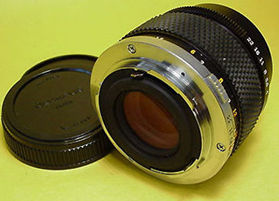 |
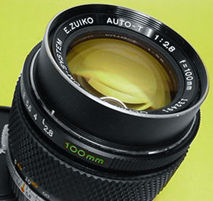 |
. |
The ZUIKO lense family has two known versions introduced thus far for the ZUIKO AUTO-T 100mm f/2.8 - but difference is mainly confined to lens coating used and minor cosmetic changes but not optically. The original version debuted along with the OM system back at the early seventies has a very simple, straight forward optical construction of 5 elements in 5 groups and the optical formula has literally unaltered all these years. Those very early version may carry a silver-chrome filter rim (or popularly referred as "silver-nose") while subsequent followed up version has it all in plain matte-black finish. Some of these early lenses may not have been multi-layers coated where some seasoned OM users think those with the lense designation "E-Zuiko" may or may not have been multicoated. Another general way for such identification is whether the lense have an indicative "MC" word added to the lens data to distinguish both groups. Well, as there is no conclusive ways for easy identification provided thus far, some users even use the reflectance of colour on the front lense element help to identify the difference of versions. Generally, as most ZUIKO lenses produced after 1982 may have "MC" imprinted along with other essential data which by far is the most accurate way of guessing. Anyway, I am not an OM expert and if it matters a lot to you, a good way is to make of of other online resources help for such identification.
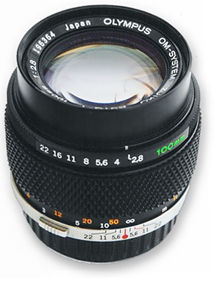 |
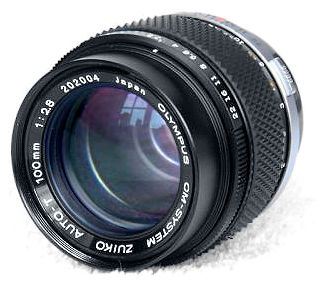 |
<<< -- Credit: Image at far left courtesy of Mr Rick Oleson® <rick_oleson@yahoo.com> who also co-maintains the popular OM Message Board in PIM site. Image Copyright © 2003. All rights reserved. |
As compared to the more glamour Zuiko equivalent of Zuiko AUTO-T 100mm f/2.0 ED, this compact zuiko lense is a more popular optic because it has a more realistic, affordable entry price than the earliar mentioned high speed Zuiko. Although this zuiko telephoto comes with a f-stop slower in its maximum lense speed, but I would rather think it offers a better value. This highly portable telephoto combines many excellent features such as compactness and lightweight with a top class image quality it delivers - Image rendition is uniformly excellent at all subject distances and aberrations are well kept under minimal level for superb image quality across its entire focusing range.
Measures at merely 48mm in length, balancing and handling for this lense with any OM bodies attached onto it is make it such a joy to use. The frame-filling 24° angle of view provides pleasing perspective where subjects are small and have a lot of details. The 100mm focal length is also a good snapshot lense because it allows the photographer to keep a comfortable distance between himself and the subject in order to retain the natural facial expression while the f/2.8 maximum aperture, other than providing a for variable creative depth of field control and should provide a good shooting experience for those who always believe investing into a slow speed zoom lenses all these while. With a compatibleTele-converter such as 2X-A , this lense may be able to extend as a 200mm f/5.6 lense.
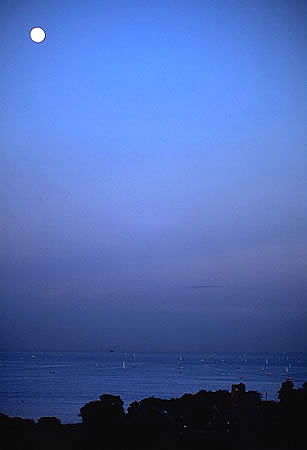 |
Overall, the 100mm is a good focal length provides virtually endless versatility in photographic applications such as multitude of subjects - sports, scenic, nature, people and photojournalism. This high performance Zuiko AUTO-T 100mm f/2.8 offers photographers an excellent alternative to the fanciful but features-rich f/2.0 Zuiko equivalent if cost is a primary factor for consideration. |
Specifications:
Current version: Zuiko AUTO-T 100mm f/2.8
Older version: E-Zuiko AUTO-T 100mm f/2.8
Focal length: 100mm
Maximum Aperture: f/2.8
Angle of View: 24°
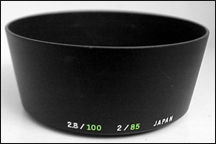 |
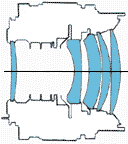 |
Optical Construction: 5 elements in 5 groups |
Weight: 235g (8.3 oz.); older
version: 230g (8.1 oz.)
Length: 48mm (1.9")
Maximum Diameter: 60mm (2.4")
Lens hood: 49mm screw-in type
Filter attachment size/Filters: 49mm screw-in
Compatible Tele-Converter:
2X-A
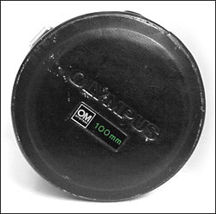 |
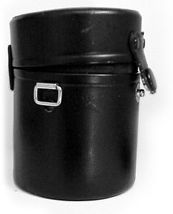 |
Recommended Focusing Screens: 1:1*, 1:2*, 1:3*, 1:4*, 1:5#, 1:6#, 1:10*, 1:13*, 1:14* |
| Previous | 2/2 Zuiko
AUTO-T 100mm f/2.0 ED
| NEXT | ZUIKO lenses at 135mm focal length
ZUIKO Telephoto lenses | 85mm | 100mm | 135mm | 180mm | 200mm | 250mm | 300mm | 350mm | 400mm | 500mm REFLEX | 600mm | 1000mm
A Brief
overview on Zuiko Optics
Zuiko Fisheye Lenses 8mm f/2.8 Circular Fisheye | 16mm
f/3.5
Full Frame Fisheye
Zuiko Ultra-Wideangle Lenses 18mm f/3.5 | 21mm f/2.0 | 21mm f/3.5 | 24mm f/2.0 | 24mm f/2.8
Zuiko Wideangle Lenses 28mm f/2.0 | 28mm f/2.8 | 28mm f/3.5 | 35mm f/2 | 35mm f/2.8 |
Zuiko Standard Lenses 40mm f/2.0 | 55mm f/1.2 | 50mm f/1.2 | 50mm f/1.4 | 50mm f/1.8 | Zuiko 50mm f/2.0 PF
Zuiko Medium-Telephoto Lenses 85mm f/2.0 | 100mm f/2.0 | 100mm f/2.8 | 135mm f/2.8 | 135mm f/3.5
Zuiko Telephoto Lenses 180mm f/2.0 EDIF | 180mm f/2.8 | 200mm f/4.0 | 200mm f/5.0 Auto-T (brief)
Zuiko Super-Telephoto Lenses 250mm f/2.0 EDIF | 300mm f/4.5 | 350mm f/2.8 EDIF | 400mm f/6.3 | 500mm | 600mm f/6.5 |1000mm f/11.0
Special application Zuiko optics: 24mm f/3.5 Shift | 35mm f/2.8 Shift | 500mm f/8 Reflex | AF Zoom 35-70mm
f/4.0
| Zuiko
50mm f/2.0 PF
Tele-Converters: 1.4X-A / 2X-A
Zuiko
Macro/Close focus lenses: Zuiko
AUTO MACRO 20mm f/3.5
| Zuiko
AUTO MACRO 20mm f/2.0
| Zuiko
AUTO MACRO 38mm f/3.5
| Zuiko
AUTO MACRO 38mm f/2.8
| Zuiko
AUTO MACRO 50mm f/3.5
| Zuiko
AUTO MACRO 50mm f/2.0
| Zuiko
AUTO MACRO 1:1 80mm f/4.0
| Zuiko
AUTO MACRO 90mm f/2.0
| Zuiko
AUTO MACRO 135mm f/4.5
Zuiko AUTO-Zoom Lenses
- Main
Index page
| S-Zuiko
AUTO Zoom 28-48mm f/4.0
|
Zuiko AUTO Zoom 35-70mm f/3.6
|
S-Zuiko AUTO Zoom 35-70mm f/4.0
|
Zuiko AF AUTO Zoom 35-70mm f/4.0
| S-Zuiko
AUTO Zoom 35-70mm f/3.5 ~ f/4.5
| S-Zuiko
AUTO Zoom 35-70mm f/3.5 ~ f/4.8
| Zuiko
AUTO Zoom 35-80mm f/2.8 ED
|
Zuiko AUTO Zoom 35-105mm f/3.5 ~ f/4.5
| Zuiko
AUTO zoom 50-250mm f/5.0
|
Zuiko AUTO zoom 65-200mm f/4.0
|
S-Zuiko AUTO zoom 70-210mm f/4.5 ~ f/5.6 | Zuiko AUTO Zoom 75-150mm f/4.0 | Zuiko AUTO Zoom
85-200mm
f/4.0
| Zuiko
AUTO Zoom 85-250mm f/5.0
| S-Zuiko
AUTO Zoom 100-200mm f/5.0
|
| Back | Index Page of OM Zuiko lenses
| Back | to Main Index Page of OM1(n) & OM2(n)
Series SLRs
| Message Board | for
your favourite Olympus
OM-1(n)
and OM-2(n)
series models
| Message
Board | for your Zuiko Optics in a shared environment
| Message Board | Specifically for Dispose or Looking for OM Photographic
Equipment
About this photographic site.
Home - Photography in Malaysia |
Copyright
© 2000.
leofoo ®. MIR Web Development Team.
Maintainers
for OM Zuiko Site & Message Board:
Rick
Oleson (Email: rick_oleson@yahoo.com Website:
http://rick_oleson.tripod.com), Bruce Hamm
(bhamm@magma.ca), John Orrell
(john@orrellj.freeserve.co.uk), Simon Evans,
(http://www.mawddwy.freeserve.co.uk); Shaun
(shaun@noemail.com), Andy Radcliffe
(AndyJRadcliffe@manx.net)
Special
thanks to:
Gregory
P. Logiodice, Bob Gries, Erwin Voogt, Joel Wilcox, Rick
Oleson, Simon Evan and many others for granting permissions to use their images
of either lenses, cameras and own pictures appeared in this Zuiko website.
Credit: My old time buddy,
Ahmad
Ikram,
Dr of Rubber Research Institute (RRI), Malaysia
who shares the same passion with me and also lending his OM-1n, OM-4 and the Motor
Drive 1 to me for preparing some images in this site; Mark Dapoz <md@dementia.org>for reminding
some broken links; Mr Poon of Foto Poon, Ipoh, Mr Richard, Ampang Park,
Mr Lim and Miss Jenny of Foto Edar for their generosity for
their OM1(n), OM2n camera and some Zuiko lenses. Mr Hans van Veluwen for
mistakenly using some content earlier from his OM website; J Sorensen
for providing some useful images to rectify some technical "flaws"; Mr
Gen Holst for helping during the early stages of development of this OM site;
Mr KKLow for some of his earlier images on the OM-1appeared in this website;
Miss Wati and Mirza for helping me
to convert this Operation Manual into a HTML format. Mr MCLau for rectifying
some mistakes made on the earlier preview sites. A personal tribute to the creator
of the OM system and also a site dedicated to all the fans of Olympuses and Zuiko
Optics worldwide. Some of the content and images appeared in this site were scanned
from OM official marketing leaflets, brochures and instruction manual(s) for educational
purposes. Olympus is a registered trade name of Olympus Optical Inc., Japan. Site
created 'unfortunately again with an IMac.